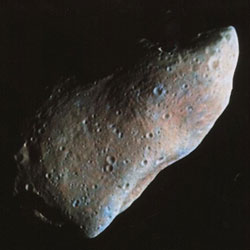
The image above is a false color view of the asteroid 951 Gaspra taken by the Galileo spacecraft. Image credit: NASA/JPL. Click to enlarge.
Important new research documenting how the Earth formed from melted asteroids 4.5 billion years ago is published in the 16 June issue of Nature. The paper was written by Dr Richard Greenwood and Dr Ian Franchi of the Open University?s Planetary and Space Sciences Research Institute (PSSRI).
“This research is important, Dr Greenwood says, ?because it demonstrates that events and processes on asteroids during the birth of the Solar System determined the present-day composition of our Earth.”
Immediately following the formation of our Solar System 4.5 billion years ago, small planetary bodies formed, with some melting to produce volcanic and related rocks. The OU researchers analysed meteorites to see how processes on asteroids may have contributed to the formation of Earth.
In their paper ?Widespread magma oceans on asteroidal bodies in the early Solar System? Drs Greenwood and Franchi show that some asteroids experienced large-scale melting, with the formation of deep magma oceans. Such melted asteroids would have become layered with lighter rock forming near the surface, while denser rocks were deeper in the interior. Since large bodies, such as Earth, grew by incorporation of many such smaller bodies these important results shed new light on the processes involved in building planets.
The researchers suggest that in the chaotic, impact-rich environment of the early Solar System, significant amounts of the outer layers of these melted asteroids would have been removed prior to becoming part of the growing Earth. This process is a better explanation for the composition of the Earth than earlier theories which called for large amounts of light elements in the Earth?s dense core, or unknown precursor materials. The Open University researchers point to recent astronomical observations which show that these processes are also important in other planetary systems, such as that around the star Beta Pictoris.
Original Source: Open University Press Release
